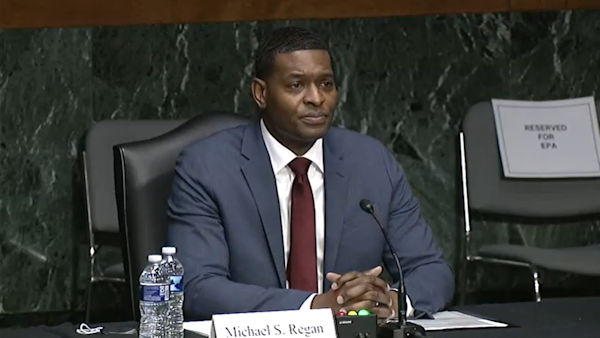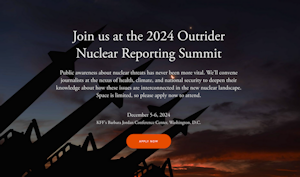SEJournal Online is the digital news magazine of the Society of Environmental Journalists. Learn more about SEJournal Online, including submission, subscription and advertising information.
 |
 |
| Michael Regan, nominee for EPA administrator, at a Feb. 3 Senate confirmation hearing. Image: U.S. Senate Committee on Environment and Public Works. Click to enlarge. |
WatchDog Opinion: Biden’s EPA, Science Agencies, Face Test of News Media Openness
By Joseph A. Davis
Is it too much to ask for a science journalist to be able to talk to a government scientist?
Reporters couldn’t do that in recent administrations at the U.S. Environmental Protection Agency.
Not without press office permission.
Not without a press office “minder” sitting in on the interview.
Not in time for a normal deadline.
Not with the specific scientist they needed to talk to.
Not without restrictions on what the scientist could discuss.
Not without questions submitted in advance.
And not without political appointees spinning the science.
Those barriers have long plagued environment reporters trying to do their jobs under both political parties at the EPA and other agencies. And the restrictions have extended to non-scientific government staff as well.
But Michael Regan, President Joe Biden’s nominee for EPA administrator, talked of “open dialogue” at his Feb. 3 Senate confirmation hearing, telling senators, “We will restore the role of science and transparency at EPA.”
So there is hope that the incoming Biden administration may set a new standard — and live up to it — for science integrity and open government in coming weeks. But the proof is yet to come.
Transparency horror stories
For years, going back long before the Trump administration, journalists wanting to interview scientists at the EPA were stiffed by the press office. The same happened at many other science and regulatory agencies. But not all. We journalists knew that truth and transparency could come from agencies like EPA because we had experienced it. We knew the difference.
But by at least the era of George W. Bush, things had changed. The horror stories were legendary.
One journalist booked an interview with a scientist at EPA’s Research Triangle Park complex and flew across the country — only to be told the interview was canceled because it hadn’t been approved by the press office. Another watched the scientist they wanted to talk to whisper words into the ear of a political appointee, who then spoke on the record for the journalist. It was very typical for a reporter to call the EPA press office asking to interview a scientist for a next-day story — only to get a call-back a week later after the story had run.
For years, the Society of Environmental Journalists has complained about EPA press policies, on behalf of its members who encountered this constant problem. We have tried informal dialogue with public affairs honchos. We have tried stern letters. We and others have reported the actual facts of how EPA has treated reporters.
Even SEJ’s WatchDog felt some hope when President Obama, on his first day in office, made a show of vowing openness (may require subscription) and issuing a memo to agencies calling for it. For reporters seeking comment from EPA scientists, however, it did not turn out that well. Toward the end of the Obama era, in Aug. 2015, some 53 journalism and open government groups (including SEJ) wrote the president urging him to end press office blockades at many agencies.
Now Biden has a chance to change all that. But bland and vague rhetoric, which is what we heard at the Regan confirmation hearing, won’t do the job.
Free advice to EPA
Almost unnoticed in the flurry of executive orders Biden issued on Jan. 27 (“Climate Day”) was a memo to agency heads on scientific integrity. It ordered agencies to adopt policies “that prevent the suppression or distortion of scientific or technological findings, data, information, conclusions, or technical results.”
The task force charged with reviewing agency policies was instructed to gather input from “stakeholders.” That should include science writers and environmental journalists.
Biden should not make the mistake of thinking that science policy is the same as news media policy. There is no written policy at EPA saying scientists can’t talk to reporters. SEJ once FOIA’d such a policy from EPA, but all we got was the historic Ruckelshaus “fishbowl memo” and a copy of EPA’s Scientific Integrity Policy.
Despite the lack of a written policy,
EPA scientists keep telling reporters they
can’t talk without press office permission.
Despite the lack of a written policy, EPA scientists keep telling reporters they can’t talk without press office permission. The Scientific Integrity Policy, adopted back in 2012, has not prevented the atrocities of the Trump era.
When administrator-designate Regan arrives at EPA (he is expected to be confirmed), he will find on his desk a letter from SEJ listing some of the things he can do to improve relations with the news media.
As environmental journalists, our job is to inform the public about what EPA is doing, not to help EPA. But here’s some free advice.
The EPA’s unwritten press policy — trying to control coverage by restricting access — does not serve EPA’s own goals, no matter what the administration. It simply drives communication off the record, and builds an atmosphere of distrust, frustration and antagonism. Journalists will get the story anyway. EPA brass, and especially EPA’s public affairs leaders, need to understand that this is bad PR.
Joseph A. Davis is a freelance writer/editor in Washington, D.C. who has been writing about the environment since 1976. He writes SEJournal Online's TipSheet, Reporter's Toolbox and Issue Backgrounder, as well as compiling SEJ's weekday news headlines service EJToday. Davis also directs SEJ's Freedom of Information Project and writes the WatchDog opinion column and WatchDog Alert.
* From the weekly news magazine SEJournal Online, Vol. 6, No. 6. Content from each new issue of SEJournal Online is available to the public via the SEJournal Online main page. Subscribe to the e-newsletter here. And see past issues of the SEJournal archived here.












 Advertisement
Advertisement 



